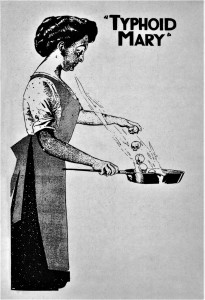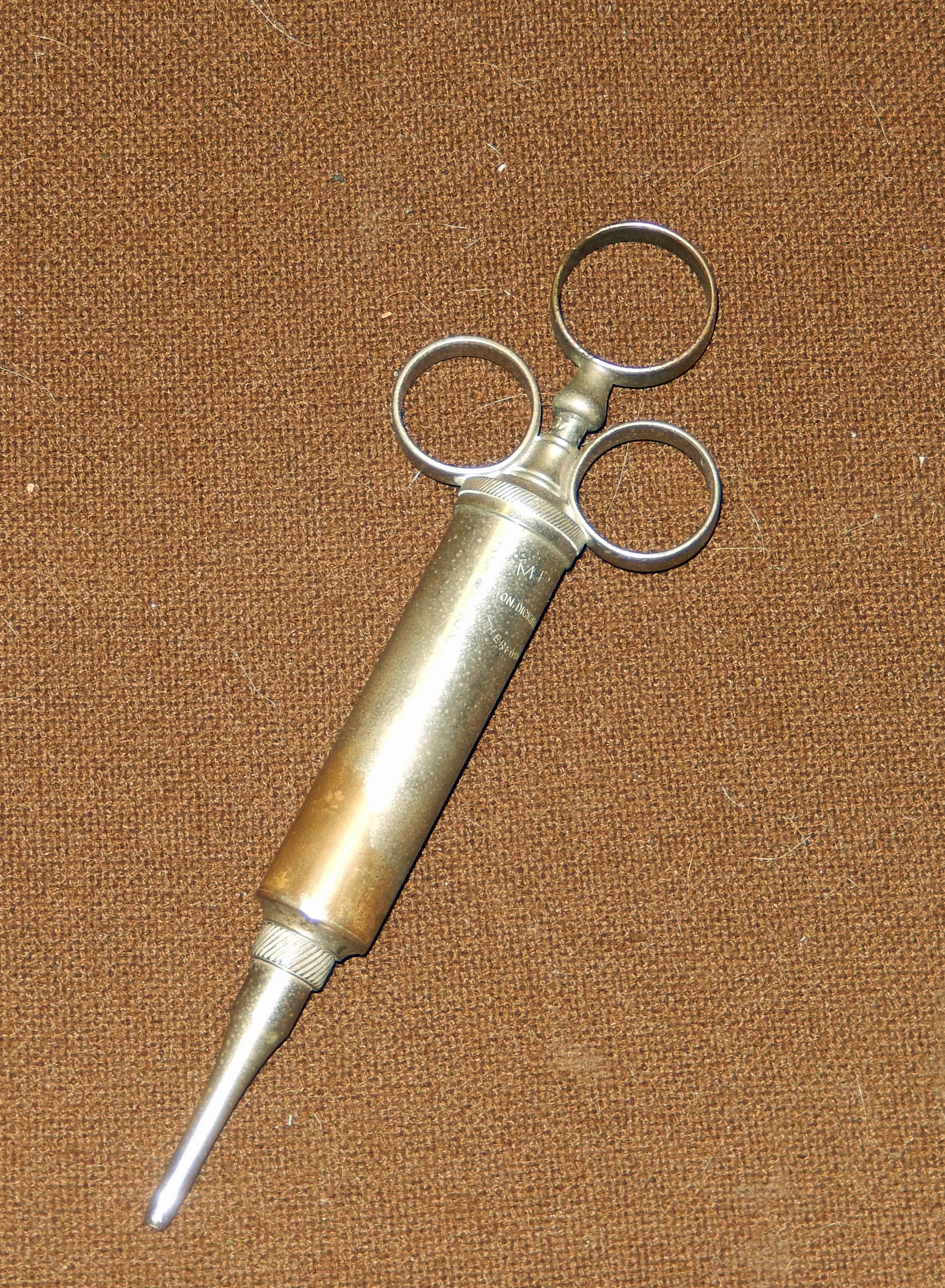Extreme fatigue; dangerously high fever; severe abdominal pain; headaches; diarrhea or constipation; nausea and vomiting – the symptoms of severe typhoid fever can be a panoply of horrors. Like cholera, the bacteria in question – Salmonella typhi, cousin to the Salmonella that causes food poisoning – find a home in water and food contaminated with human feces. The infection is contracted only by humans, and it is highly contagious. More persons contract it from human contact – often from unwashed hands following defecation – than from drinking contaminated water or ingesting contaminated food. But the latter are hardly incidental causes. At least two billion people worldwide, the World Health Organization tells us, drink feces-contaminated water.[1]
And the story gets worse. Through the 19th century, “chronic carriers” could not be conceptualized, much less detected. They were symptom-free folks in whom typhi found safe harbor in the gall bladder, where they traveled with stored bile through the bile duct into the small intestine en route to fecal expulsion. The chronic carriers brought infection to entire communities in sudden, explosive outbreaks; typhoid is a prime example of what epidemiologists term a “fulminant” disease (from the Latin fulmināre, to strike with lightning). And worse still, the ranks of common carriers were enlarged by some of those who contracted the disease and recovered. Typhi lived on in their gall bladders as well, and were passed on to others via the same fecal-oral route.
The Mother of all Common Carriers, the Super Spreader who comes down to us as Typhoid Mary, was one Mary Mallon, an Irish cook who passed on typhi to no less than 53 members of seven prominent Manhattan-area households between 1900 and 1906. In 1907 she was quarantined in a bungalow on New York’s North Brother Island near Riverside Hospital, only to resume her career as cook-super spreader on release in 1910. Tracked down five years later, she was whisked back to her island bungalow, where she lived out her remaining 23 years.
An illustration of Typhoid Mary hard at work cracking skulls into a skillet. It appeared in “The New York American” in 1909, and carried the subtitle, “The Extraordinary Predicament of Mary Mallon, a Prisoner of New York’s Quarantine Hospital.”
Here is what Salmonella typhi do once ingested through the mouth. Absent sufficient gastric acid to neutralize them in the stomach, the bacteria make their way to the terminal of the small intestine and enter the cells lining it. Intestinal cells respond to the invaders with a massive inflammatory response that leads to an intestinal rupture, a hole, through which intestinal contents drain into the abdomen, with attendant and severe pain. And from there matters go from bad to worse. Without fast, effective treatment, the bacteria penetrate lymphatic tissue and enter the blood stream, which shuttles them to other organs: the liver, the spleen, bone marrow. In the worst cases, bacterial ulceration can extend all the way to the terminal lining of the ileum, from which typhi flood the body, carrying infection to the brain, heart, and pancreas. Death is now around the corner; only major abdominal surgery holds any prospect of survival. It is a pernicious disease of microbial migratory urgency.
Improvements in water treatment and personal hygiene, along with antibiotic therapy and – yes! – a newly effective vaccine for adults, brought typhoid to its knees in the United States after World War II. But the disease is alive and well in Central and South America, Africa, and parts of Asia, where it claims between 11 and 21 million victims and some 200,000 deaths each year.[2] Typhi has evolved along with the antibiotics that control it, and multidrug-resistant strains (MDR) remain deadly. And even here, on these ostensibly sanitized shores, typhi can still make its presence known. As recently as 2010, nine Americans contracted typhoid, five in California and four in Nevada.[3]
But such instances are aberrational, and in the northern hemisphere typhoid fever has long since vanished from anyone’s disease-monitoring radar. Now federal and state governments, the bane of anti-vaccine irrationalists and mask-wearing naysayers, make sure we don’t drink water or eat food contaminated by microbe-laced feces. But it was not so for our forebears. In the Civil War, typhoid fever devastated north and south alike; the Union Army’s general hospital, the Satterlee Hospital in West Philadelphia, was constructed in 1862 largely to cope with its victims. In the Spanish-American War of 1898, typhoid fever shared center stage with yellow fever and, at war’s end, rated its own federal investigative commission. Chaired by Walter Reed, the Typhoid Commission determined that contact among soldiers (“comrade contact”) was primarily responsible for the transmission of typhoid fever in military camps.[4] Four years later, Koch’s investigations during a typhoid epidemic in Trier, Germany led him to generalize the Commission’s finding: typhoid fever was contracted less from contaminated water or sewage than from nonsymptomatic carriers; the “carrier hypothesis” was among his final significant contributions.[5]
The era of modern typhoid prevention began in 1897, when Almroth Wright, then a pathologist at the British Army’s Medical School at Netley Hospital, published a paper on the typhoid vaccine he had developed with killed typhi. The Army took note and, in the South African war the following year, made very limited use of it: of 330,000 British troops, only 14,000 received the vaccine. It was effective in this limited trial but never caught on after the war.[6] Beginning in 1902, the U.S. government’s Public Health and Marine Hospital Service, renamed the Public Health Service in 1912, focused its research on typhoid. Progress was made, and by the time America entered WWI, the PHS’s Hygienic Laboratory had developed an antityphoid vaccine.[7] American troops sailing to France in 1917 were not asked how they felt about receiving a typhoid vaccine; they received their mandatory shots and boarded their ships. Those who were not vaccinated stateside received their shots on arriving at their camps. Vaccination was not negotiable. The obligation to live and fight for the nation trumped the freedom to be free to contract typhoid, suffer, and possibly die.

The vaccine dramatically reduced the incidents of typhoid, but it still wrought damage in field and base hospitals, especially among unvaccinated European troops who had been fighting since 1914. American nurses who arrived in northern France and Belgium in advance of troops recalled their misery at being transferred to typhoid wards, which, as one recalled were “gloomy and dark.” Another recalled a typhoid scourge that crippled her hospital and created an urgent need to find space outside the hospital for the typhoid patients.[8]
_______________________________
The current governors of Texas and Florida would surely look askance at the history of typhoid control, since a key aspect of it – allowing children on school premises to drink only water subjected to antimicrobial treatment – ignores parental freedom of choice. Parents decide what their children eat, and they should be free to determine what kind of water they drink. Children are not military enlistees obligated to remain healthy in the service of the nation. What right do schools boards have to abrogate the freedom of parents to determine what kind of water their children drink? Why should they be mandated to drink water subject to modern sanitary treatment that robs it of Salmonella typhi along with Vibrio cholerae, Poliovirus, and dysentery-causing Shigella? Shouldn’t they be free to have their children partake of nature’s bounty, to drink fresh water from streams and rivers, not to mention untreated well water contaminated with human feces and the pathogens it harbors?
And here is the Covid connection. If local school boards and municipal authorities lack the authority to safeguard children, to the extent possible, through obligatory wearing of facemasks, then surely they lack the authority to force them to drink water filtered through layers of state and federal regulation informed by modern science. Let parents be free to parent; let their children pay the steep, even life-threatening price.
Did I mention that young children, along with immune-compromised young adults, are at greatest risk for contracting typhoid? Well, now you know, and now, perhaps, we can return to reality. State governors who do not understand the legal and moral imperative of acting in the best interests of the child[9] are unfit for public office of any sort. In point of fact, they are unfit. Who wants governors who, in denying adults the right to act responsibly in the best interests of children, sanction child abuse? Let them crawl back into the existential dung heap whence they emerged.
[1] https://www.who.int/news-room/fact-sheets/detail/drinking-water.
[2] https://www.cdc.gov/typhoid-fever/health-professional.html,
[3] https://www.cdc.gov/salmonella/2010/frozen-fruit-pulp-8-25-10.html.
[4] Victor C. Vaughan, A Doctor’s Memories (Indianapolis: Bobbs-Merrill, 1926), 369ff., 386.
[5] Thomas D. Brock, Robert Koch: A Life in Medicine and Bacteriology (Wash, DC: ASM Press, 1998 [1988]), 255-256.
[6] Gywn Macfarlane, Alexander Fleming: The Man and the Myth (Cambridge: Harvard University Press, 1984), 54-55.
[7] Victoria A. Harden, Inventing the NIH: Federal Biomedical Research Policy, 1887-1937 (Baltimore: Johns Hopkins University Press, 1986), 41.
[8] Grace McDougall, A Nurse at the War: Nursing Adventures in Belgium and France (NY: McBride, 1917), 111, 117; Alice Isaacson, Diary of 1917, Library & Archives, Canada, letter of 16 February 1917.
[9] Joseph Goldstein, Anna Freud, et al., In the Best Interests of the Child (New York: Free Press, 1986).
Copyright © 2021 by Paul E. Stepansky. All rights reserved. The author kindly requests that educators using his blog essays in courses and seminars let him know via info[at]keynote-books.com.








